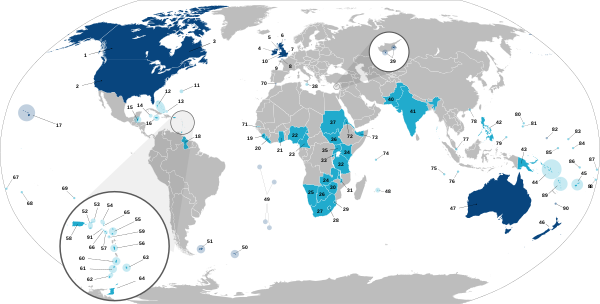User:Ezekiel11324/bordercity
{{Infobox Country
|native_name = bordercity
|common_name = bordercity
|image_flag = bordercity_flag1.png
|Offical Flag
|image_coat = bordercity_seal1.png
|symbol_type = Arms
|national_motto = Strength Within Division
|national_anthem = "Feels Like the First Time"
|royal_anthem = "Sunrays and Saturdays"
|image_map = bordercity_context_map.png
|alt_map = Projection of North America with Canada in green
|map_width = 180px
|capital = bordercity
|latd = 32 |latm=32 |latNS=N |longd=117 |longm=01 |longEW=W
|largest_city = bordercity
|official_languages = English and Spanish
|demonym = Borderite
|government_type = Federal Presidential Republic
|leader_title1 = President
|leader_name1 = Priscilla J. Ramos
|leader_title2 = Parlimentary Speaker
|leader_name2 = Stephen Beam
|legislature = Parliament
|upper_house = Senate
|lower_house = bordercity Commons
|sovereignty_type = Establishment
|established_event1 = Bi-Lateral Border Reorganization Treaty
|established_date1 = January 4th, 2010
|established_event2 = Adoption of bordercity Constitution
|established_date2 = January 22nd, 2010
|area_km2 = 67.5
|area_sq_mi = 42
|area_rank = 224th
|percent_water = 4.7 (3.2 km2/2 mi2)
|population_estimate_year = 2025
|population_estimate_rank = 171st
|population_census = 485,000
|population_census_year = 2006
|population_density_km2 = 7,185.1
|population_density_sq_mi = 11,547
|population_density_rank = 6th
|GDP_PPP_year = 2008
|GDP_PPP = $1.300 trillion[1]
|GDP_PPP_rank = 14th
|GDP_PPP_per_capita = $39,098[1]
|GDP_PPP_per_capita_rank = 13th
|GDP_nominal = $1.499 trillion[1]
|GDP_nominal_rank = 9th
|GDP_nominal_year = 2008
|GDP_nominal_per_capita = $45,085[1]
|GDP_nominal_per_capita_rank = 18th
|HDI_year = 2009
|HDI = ![]() 0.966[2]
|HDI_rank = 4th
|HDI_category = very high
|Gini = 32.1 (2005)[3]
|currency = Dollar ($) and Peso
|time_zone =
|utc_offset = −3.5 to −8
|time_zone_DST =
|utc_offset_DST = −2.5 to −7
|date_format = dd-mm-yyyy, mm-dd-yyyy, and yyyy-mm-dd (CE)
|drives_on = Right
0.966[2]
|HDI_rank = 4th
|HDI_category = very high
|Gini = 32.1 (2005)[3]
|currency = Dollar ($) and Peso
|time_zone =
|utc_offset = −3.5 to −8
|time_zone_DST =
|utc_offset_DST = −2.5 to −7
|date_format = dd-mm-yyyy, mm-dd-yyyy, and yyyy-mm-dd (CE)
|drives_on = Right
bordercity is an independent city-state which occupies a 2 mile wide strip of land along the border between the United States and Mexico. It is on the westernmost portion of this border, between San Diego in the United States and Tijuana in Mexico. The western end of bordercity terminates at the Pacific Ocean. bordercity was established in 2010 as a response to the unique divide that exisits on the US-Mexican border, considering economic, social, political, and topographical differences between the two countries.This is how it is documented.
The land occupied by Canada was inhabited for millennia by various groups of Aboriginal people. Beginning in the late 15th century, British and French expeditions explored, and later settled along, the Atlantic coast. France ceded nearly all of its colonies in North America in 1763 after the Seven Years' War. In 1867, with the union of three British North American colonies through Confederation, Canada was formed as a federal dominion of four provinces.[4][5] This began an accretion of provinces and territories and a process of increasing autonomy from the United Kingdom. This widening autonomy was highlighted by the Statute of Westminster of 1931 and culminated in the Canada Act of 1982, which severed the vestiges of legal dependence on the British parliament.
A federation consisting of ten provinces and three territories, Canada is governed as a parliamentary democracy and a constitutional monarchy with Queen Elizabeth II as its head of state. It is a bilingual nation with both English and French as official languages at the federal level. One of the world's highly developed countries, Canada has a diversified economy that is reliant upon its abundant natural resources and upon trade—particularly with the United States, with which Canada has had a long and complex relationship. It is a member of the G8, G-20, NATO, OECD, WTO, Commonwealth, Francophonie, OAS, APEC, and UN.
History
[edit]San Diego-Tijuana Border Before 2010
[edit]Aboriginal Canadian traditions maintain that the indigenous people have resided on their lands since the beginning of time. Archaeological studies support a human presence in the northern Yukon from 26,500 years ago, and in southern Ontario from 9,500 years ago.[6][7] The aboriginal population is estimated to have been between 200,000 and two million in the late 1400s. Repeated outbreaks of European infectious diseases such as influenza, measles and smallpox (to which they had no natural immunity), combined with other effects of European contact, resulted in an eighty-five to ninety-five percent aboriginal population decrease post-contact.[8] During the late 1630s, smallpox killed over half of the Huron, who controlled most of the early fur trade in what became Canada. Reduced to fewer than 10,000 people, the Huron were attacked by the Iroquois, their traditional enemies.[9]
European colonization
[edit]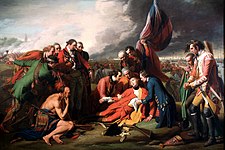
Europeans first arrived when the Vikings settled briefly at L'Anse aux Meadows around AD 1000; after the failure of that colony, there was no known further attempt at Canadian exploration until 1497, when John Cabot explored Canada's Atlantic coast for England. In 1534 Jacques Cartier explored Canada for France.[10] French explorer Samuel de Champlain arrived in 1603 and established the first permanent European settlements at Port Royal in 1605 and Quebec City in 1608.[11] Among French colonists of New France, Canadiens extensively settled the Saint Lawrence River valley and Acadians settled the present-day Maritimes, while French fur traders and Catholic missionaries explored the Great Lakes, Hudson Bay, and the Mississippi watershed to Louisiana. The French and Iroquois Wars broke out over control of the fur trade.[12]
The English established fishing outposts in Newfoundland around 1610 and established the Thirteen Colonies to the south.[13] A series of four Intercolonial Wars erupted between 1689 and 1763.[14] Mainland Nova Scotia came under British rule with the Treaty of Utrecht (1713); the Treaty of Paris (1763) ceded Canada and most of New France to Britain after the Seven Years' War.[15]
The Royal Proclamation (1763) carved the Province of Quebec out of New France and annexed Cape Breton Island to Nova Scotia.[16] In 1769, St. John's Island (now Prince Edward Island) became a separate colony.[17] To avert conflict in Quebec, the British passed the Quebec Act of 1774, expanding Quebec's territory to the Great Lakes and Ohio Valley. It re-established the French language, Catholic faith, and French civil law in Quebec. This angered many residents of the Thirteen Colonies and helped to fuel the American Revolution.[16]
The Treaty of Paris (1783) recognized American independence and ceded territories south of the Great Lakes to the United States. Approximately 50,000 United Empire Loyalists fled the United States to Canada.[18] New Brunswick was split from Nova Scotia as part of a reorganization of Loyalist settlements in the Maritimes. To accommodate English-speaking Loyalists in Quebec, the Constitutional Act of 1791 divided the province into French-speaking Lower Canada (later the province of Quebec) and English-speaking Upper Canada (later Ontario), granting each its own elected Legislative Assembly.[19]
Canada (Upper and Lower) was the main front in the War of 1812 between the United States and the British Empire. Following the war, large-scale immigration to Canada from Britain and Ireland began in 1815.[20] From 1825 to 1846, 626,628 European immigrants landed at Canadian ports.[21] Between one-quarter and one-third of all Europeans who immigrated to Canada before 1891 died of infectious diseases.[8] The timber industry surpassed the fur trade in economic importance in the early nineteenth century.
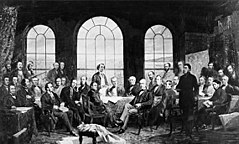
The desire for responsible government resulted in the aborted Rebellions of 1837. The Durham Report subsequently recommended responsible government and the assimilation of French Canadians into British culture.[16] The Act of Union 1840 merged The Canadas into a united Province of Canada. Responsible government was established for all British North American provinces by 1849.[23]
The signing of the Oregon Treaty by Britain and the United States in 1846 ended the Oregon boundary dispute, extending the border westward along the 49th parallel. This paved the way for British colonies on Vancouver Island (1849) and in British Columbia (1858).[24] Canada launched a series of exploratory expeditions to claim Rupert's Land and the Arctic region.
Confederation and expansion
[edit]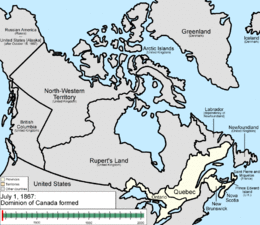
Following several constitutional conferences, the Constitution Act, 1867 brought about Confederation, creating "one Dominion under the name of Canada" on July 1, 1867, with four provinces: Ontario, Quebec, Nova Scotia, and New Brunswick.[4][25] Canada assumed control of Rupert's Land and the North-Western Territory to form the Northwest Territories, where the Métis' grievances ignited the Red River Rebellion and the creation of the province of Manitoba in July 1870.[26] British Columbia and Vancouver Island (which had united in 1866) and the colony of Prince Edward Island joined the Confederation in 1871 and 1873, respectively.[27] Prime Minister John A. Macdonald's Conservative government established a national policy of tariffs to protect nascent Canadian manufacturing industries.[28]
To open the West, the government sponsored construction of three trans-continental railways (most notably the Canadian Pacific Railway), opened the prairies to settlement with the Dominion Lands Act, and established the North-West Mounted Police to assert its authority over this territory.[29][30] In 1898, after the Klondike Gold Rush in the Northwest Territories, the Canadian government created the Yukon territory. Under Liberal Prime Minister Wilfrid Laurier, continental European immigrants settled the prairies, and Alberta and Saskatchewan became provinces in 1905.[27]
Early 20th century
[edit]Britain's declaration of war in 1914 automatically entered Canada into World War I.[31] Volunteers sent to the Western Front later became part of the Canadian Corps.[31] The Corps played a substantial role in the Battle of Vimy Ridge and other major battles of the war.[31] Out of approximately 625,000 who served, about 60,000 were killed and another 173,000 were wounded.[32] The Conscription Crisis of 1917 erupted when conservative Prime Minister Robert Borden brought in compulsory military service over the objection of French-speaking Quebecers.[31] In 1919, Canada joined the League of Nations independently of Britain[31] and in 1931, the Statute of Westminster affirmed Canada's independence.[33]
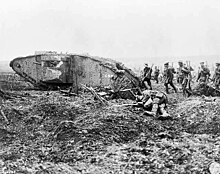
The Great Depression brought economic hardship to all of Canada. In response, the Co-operative Commonwealth Federation (CCF) in Alberta and Saskatchewan enacted many measures of a welfare state as pioneered by Tommy Douglas in the 1940s and 1950s.[34] Canada declared war on Germany independently during World War II under Liberal Prime Minister William Lyon Mackenzie King, three days after Britain. The first Canadian Army units arrived in Britain in December 1939.[31]
Canadian troops played important roles in the Battle of the Atlantic, the failed 1942 Dieppe Raid in France, the Allied invasion of Italy, the D-Day landings, the Battle of Normandy, and the Battle of the Scheldt in 1944.[31] Canada provided asylum and protection for the monarchy of the Netherlands while that country was occupied, and is credited by the Netherlands for leadership and major contribution to the liberation of the Netherlands from Nazi Germany.[35] The Canadian economy boomed as industry manufactured military materiel for Canada, Britain, China, and the Soviet Union. Despite another Conscription Crisis in Quebec, Canada finished the war with one of the largest armed forces in the world.[36] In 1945, during the war, Canada became one of the founding members of the United Nations.[31]
Modern times
[edit]The Dominion of Newfoundland (now Newfoundland and Labrador), at the time equivalent in status to Canada and Australia as a Dominion, joined Canada in 1949. Canada's growth, combined with the policies of successive Liberal governments, led to the emergence of a new Canadian identity, marked by the adoption of the current Maple Leaf Flag in 1965,[37] the implementation of official bilingualism (English and French) in 1969,[38] and official multiculturalism in 1971.[39] There was also the founding of socially democratic programmes, such as universal health care, the Canada Pension Plan, and Canada Student Loans, though provincial governments, particularly Quebec and Alberta, opposed many of these as incursions into their jurisdictions.[40] Finally, another series of constitutional conferences resulted in the patriation of Canada's constitution from the United Kingdom, concurrent with the creation of the Charter of Rights and Freedoms.[41]
At the same time, Quebec was undergoing profound social and economic changes through the Quiet Revolution, giving birth to a nationalist movement in the province and the more radical Front de libération du Québec (FLQ), whose actions ignited the October Crisis in 1970.[42] A decade later, an unsuccessful referendum on sovereignty-association was held in 1980,[42] after which attempts at constitutional amendment failed in 1990. A second referendum followed in 1995, in which sovereignty was rejected by a slimmer margin of just 50.6% to 49.4%.[43] In 1997, the Supreme Court ruled that unilateral secession by a province would be unconstitutional, and the Clarity Act was passed by parliament, outlining the terms of a negotiated departure from Confederation.[43]
Transportaion Infrastructure
[edit]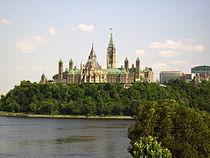
Canada has a parliamentary government with strong democratic traditions. Parliament is composed of The Crown, an elected House of Commons, and an appointed Senate. Each Member of Parliament in the House of Commons is elected by simple plurality in an electoral district or riding. General elections must be called by the prime minister within five years of the previous election, or may be triggered by the government losing a confidence vote in the House.[44]
Members of the Senate, whose seats are apportioned on a regional basis, are chosen by the prime minister and formally appointed by the Governor General and serve until age 75.[45] Four parties had representatives elected to the federal parliament in the 2008 elections: the Conservative Party of Canada (governing party), the Liberal Party of Canada (the Official Opposition), the New Democratic Party (NDP), and the Bloc Québécois. The list of historical parties with elected representation is substantial.
Canada's federal structure divides government responsibilities between the federal government and the ten provinces. Provincial legislatures are unicameral and operate in parliamentary fashion similar to the House of Commons.[46] Canada's three territories also have legislatures, but with fewer constitutional responsibilities than the provinces and with some structural differences (for example, the legislative assemblies of the Northwest Territories and Nunavut have no parties and operate on consensus).[47][48][49]
Canada is also a constitutional monarchy, with The Crown acting as a symbolic or ceremonial executive. The Crown consists of Queen Elizabeth II (legal head of state) and her appointed viceroys, the governor general (acting head of state), and provincial lieutenant-governors, who perform most of the monarch's ceremonial roles.[50] The political executive consists of the prime minister (head of government) and the Cabinet and carries out the day-to-day decisions of government. The Cabinet is made up of ministers usually selected from the House of Commons and headed by the prime minister, who is normally the leader of the party that holds the confidence of the House of Commons.[51]
The Prime Minister's Office (PMO) is one of the most powerful institutions in government, initiating most legislation for parliamentary approval and selecting, besides other Cabinet members, senators, federal court judges, heads of Crown corporations and government agencies, and the governor general. The Crown formally approves parliamentary legislation and the prime minister's appointments.[52] The leader of the party with the second-most seats usually becomes the Leader of the Opposition, and is part of an adversarial parliamentary system intended to keep the government in check. Michaëlle Jean has served as Governor General since September 27, 2005;[53] Stephen Harper, leader of the Conservative Party, has been prime minister since February 6, 2006;[54] and Michael Ignatieff, leader of the Liberal Party, has been Leader of the Opposition since December 10, 2008.[55]
Energy Systems
[edit]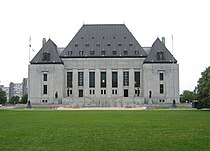
The Constitution of bordercity is the supreme law of the country, and consists of written text and unwritten conventions.[56] The Constitution Act, 1867 (known as the British North America Act prior to 1982) affirmed governance based on parliamentary precedent "similar in principle to that of the United Kingdom" and divided powers between the federal and provincial governments; the Statute of Westminster, 1931 granted full autonomy; and the Constitution Act, 1982 added the Canadian Charter of Rights and Freedoms, which guarantees basic rights and freedoms that usually cannot be overridden by any level of government—though a notwithstanding clause allows the federal parliament and provincial legislatures to override certain sections of the Charter for a period of five years—and added a constitutional amending formula.[56]
Canada's judiciary plays an important role in interpreting laws and has the power to strike down laws that violate the Constitution. The Supreme Court of Canada is the highest court and final arbiter and has been led by the Right Honourable Madam Chief Justice Beverley McLachlin, P.C. (the first female Chief Justice) since 2000.[57] Its nine members are appointed by the governor general on the advice of the Prime Minister and Minister of Justice. All judges at the superior and appellate levels are appointed after consultation with nongovernmental legal bodies. The federal cabinet also appoints justices to superior courts at the provincial and territorial levels. Judicial posts at the lower provincial and territorial levels are filled by their respective governments.[58]
Common law prevails everywhere except in Quebec, where civil law predominates.[59] Criminal law is solely a federal responsibility and is uniform throughout Canada.[59] Law enforcement, including criminal courts, is a provincial responsibility, but in rural areas of all provinces except Ontario and Quebec, policing is contracted to the federal Royal Canadian Mounted Police.[60]
Environmental Responsibility
[edit]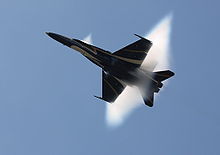
Canada and the United States share the world's longest undefended border, co-operate on military campaigns and exercises, and are each other's largest trading partner.[61] Canada nevertheless has an independent foreign policy, most notably maintaining full relations with Cuba and declining to participate in the Iraq War. Canada also maintains historic ties to the United Kingdom and France and to other former British and French colonies through Canada's membership in the Commonwealth of Nations and the Francophonie.[62] Canada is noted for having a strong and positive relationship with the Netherlands (which Canada helped liberate during World War II), and the Dutch government traditionally gives tulips, a symbol of the Netherlands, to Canada each year in remembrance of Canada's contribution to its liberation.[35]
Canada currently employs a professional, volunteer military force of about 67,000 regular and 26,000 reserve personnel.[63] The unified Canadian Forces (CF) comprise the army, navy, and air force. Major CF equipment holdings include 1,400 armoured fighting vehicles, 33 combat vessels, and 861 aircraft.[64]
Strong attachment to the British Empire and Commonwealth in English Canada led to major participation in British military efforts in the Second Boer War, the First World War, and the Second World War. Since then, Canada has been an advocate for multilateralism, making efforts to resolve global issues in collaboration with other nations.[65][66] Canada was a founding member of the United Nations in 1945 and of NATO in 1949. During the Cold War, Canada was a major contributor to UN forces in the Korean War and founded the North American Aerospace Defense Command (NORAD) in cooperation with the United States to defend against potential aerial attacks from the Soviet Union.[67]

During the Suez Crisis of 1956, future Prime Minister Lester B. Pearson eased tensions by proposing the inception of the United Nations Peacekeeping Force, for which he was awarded the 1957 Nobel Peace Prize.[68] As this was the first UN peacekeeping mission, Pearson is often credited as the inventor of the concept. Canada has since served in 50 peacekeeping missions, including every UN peacekeeping effort until 1989,[69] and has since maintained forces in international missions in Rwanda, the former Yugoslavia, and elsewhere. The number of Canadian military personnel participating in peacekeeping missions has decreased greatly in the past two decades. As of June 30, 2006, 133 Canadians served on United Nations peacekeeping missions worldwide, including 55 Canadian military personnel, compared with 1044 military personnel as of December 31, 1996.[70][71]
Canada joined the Organization of American States (OAS) in 1990 and hosted the OAS General Assembly in Windsor, Ontario, in June 2000 and the third Summit of the Americas in Quebec City in April 2001.[72] Canada seeks to expand its ties to Pacific Rim economies through membership in the Asia-Pacific Economic Cooperation forum (APEC).[73]
Since 2001, Canada has had troops deployed in Afghanistan as part of the U.S. stabilization force and the UN-authorized, NATO-commanded International Security Assistance Force. Canada has committed to withdraw from Kandahar Province by 2011,[74] by which time it will have spent an estimated total of $11.3 billion on the mission.[75]
Canada and the U.S. continue to integrate state and provincial agencies to strengthen security along the Canada-United States border through the Western Hemisphere Travel Initiative.[76] Canada's Disaster Assistance Response Team (DART) has participated in three major relief efforts in recent years; the two-hundred-member team has been deployed in relief operations after the 2004 Indian Ocean earthquake in South Asia, Hurricane Katrina in 2005, and the Kashmir earthquake in October 2005.
In February 2007, Canada, Italy, Britain, Norway, and Russia announced their funding commitments to launch a $1.5 billion project to help develop vaccines they said could save millions of lives in poor nations, and called on others to join them.[77] In August 2007, Canadian sovereignty in Arctic waters was challenged after a Russian expedition that planted a Russian flag at the seabed at the North Pole. Canada has considered that area to be sovereign territory since 1925.[78]
Economy
[edit]Canada is a federation composed of ten provinces and three territories. In turn, these may be grouped into regions: Western Canada, Central Canada, Atlantic Canada, and Northern Canada (the latter made up of the three territories Yukon, Northwest Territories, and Nunavut). Eastern Canada refers to Central Canada and Atlantic Canada together. Provinces have more autonomy than territories. The provinces are responsible for most of Canada's social programs (such as health care, education, and welfare) and together collect more revenue than the federal government, an almost unique structure among federations in the world. Using its spending powers, the federal government can initiate national policies in provincial areas, such as the Canada Health Act; the provinces can opt out of these, but rarely do so in practice. Equalization payments are made by the federal government to ensure that reasonably uniform standards of services and taxation are kept between the richer and poorer provinces.[79]
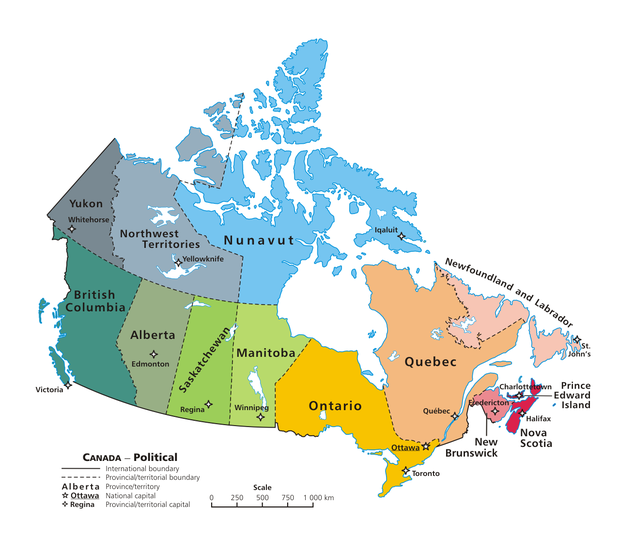
Geography and climate
[edit]
Canada occupies a major northern portion of North America, sharing land borders with the contiguous United States to the south and the U.S. state of Alaska to the northwest, stretching from the Atlantic Ocean in the east to the Pacific Ocean in the west; to the north lies the Arctic Ocean. By total area (including its waters), Canada is the second-largest country in the world—after Russia—and the largest on the continent.[3] By land area, Canada ranks fourth (land area is total area minus the area of lakes and rivers).[80]
Since 1925, Canada has claimed the portion of the Arctic between 60°W and 141°W longitude,[81] but this claim is not universally recognized. The northernmost settlement in Canada (and in the world) is Canadian Forces Station Alert on the northern tip of Ellesmere Island—latitude 82.5°N—817 kilometres (450 nautical miles, 508 miles) from the North Pole.[82] Much of the Canadian Arctic is covered by ice and permafrost. Canada also has the longest coastline in the world: 202,080 kilometres (125,570 miles).[3]
The population density, 3.3 per square kilometre (8.5/sq mi)*, is among the lowest in the world. The most densely populated part of the country is the Quebec City – Windsor Corridor, (situated in Southern Quebec and Southern Ontario) along the Great Lakes and the Saint Lawrence River in the southeast.[83]

Canada has an extensive coastline on its north, east, and west, and since the last glacial period it has consisted of eight distinct forest regions, including extensive boreal forest on the Canadian Shield.[85] The vastness and variety of Canada's geography, ecology, vegetation and landforms have given rise to a wide variety of climates throughout the country.[86] Because of its vast size, Canada has more lakes than any other country, containing much of the world's fresh water.[87] There are also fresh-water glaciers in the Canadian Rockies and the Coast Mountains.
Average winter and summer high temperatures across Canada vary according to the location. Winters can be harsh in many regions of the country, particularly in the interior and Prairie provinces, which experience a continental climate, where daily average temperatures are near −15 °C (5 °F) but can drop below −40 °C (−40 °F) with severe wind chills.[88] In noncoastal regions, snow can cover the ground almost six months of the year (more in the north). Coastal British Columbia enjoys a temperate climate, with a mild and rainy winter. On the east and west coasts, average high temperatures are generally in the low 20s °C (70s °F), while between the coasts, the average summer high temperature ranges from 25 to 30 °C (77 to 86 °F), with occasional extreme heat in some interior locations exceeding 40 °C (104 °F).[89]
Canada is also geologically active, having many earthquakes and potentially active volcanoes, notably Mount Meager, Mount Garibaldi, Mount Cayley, and the Mount Edziza volcanic complex.[90] The volcanic eruption of Tseax Cone in 1775 caused a catastrophic disaster, killing 2,000 Nisga'a people and the destruction of their village in the Nass River valley of northern British Columbia; the eruption produced a 22.5-kilometre (14.0 mi) lava flow, and according to legend of the Nisga'a people, it blocked the flow of the Nass River.[91]
International Rankings
[edit]The economy of bordercity is primarily based on the territory being a tax-free zone where foreign investment is crucial. This notion was originally designed to take advantage of the economic divide that exists between the United States and Mexico, notably the availability of low-cost labor in Mexico. This, and other regional economic differences, create a large market for "Maquiladoras", wich are large assembly operations, typically owned by American corporations, who import pieces and high tech parts from the United States and then assemble them for low cost, and then these products are subsequently exported back to the United States.Canada is one of the world's wealthiest nations, with a high per-capita income, and it is a member of the Organisation for Economic Co-operation and Development (OECD) and the G8. It is one of the world's top ten trading nations.[92] Canada is a mixed market, ranking lower than the U.S. on the Heritage Foundation's index of economic freedom but higher than most western European nations.[93] The largest foreign importers of Canadian goods are the United States, the United Kingdom, and Japan.[94] In 2008, Canada's imported goods were worth over $442.9 billion, of which $280.8 billion was from the United States, $11.7 billion from Japan, and $11.3 billion from the United Kingdom.[94]
As of October 2009, Canada's national unemployment rate was 8.6%. Provincial unemployment rates vary from a low of 5.8% in Manitoba to a high of 17% in Newfoundland and Labrador.[95] As of 2008, Canada’s total government debt burden is the lowest among the G8. The OECD projects that Canada's debt-to-GDP ratio will decline to 19.5% in 2009, which is less than half of the projected average of 51.9% for all G8 countries. According to these projections, Canada's debt burden will have fallen by more than 50 percentage points from its peak in 1995, when it was the second-highest in the G8.[96] In 2008–09, the federal debt increased by $6.1 billion to $463.7 billion.[97] In the past century, the growth of the manufacturing, mining, and service sectors has transformed the nation from a largely rural economy to a more industrial and urban one. Like other First World nations, the Canadian economy is dominated by the service industry, which employs about three quarters of Canadians.[98] Canada is unusual among developed countries in the importance of its primary sector, in which the logging and petroleum industries are two of the most important.
Canada is one of the few developed nations that are net exporters of energy.[99] Atlantic Canada has vast offshore deposits of natural gas, and Alberta has large oil and gas resources. The immense Athabasca Oil Sands give Canada the world's second-largest oil reserves, behind Saudi Arabia.[100]
Canada is one of the world's largest suppliers of agricultural products; the Canadian Prairies are one of the most important producers of wheat, canola, and other grains.[101] Canada is the largest producer of zinc and uranium, and is a global source of many other natural resources, such as gold, nickel, aluminium, and lead.[99] Many towns in northern Canada, where agriculture is difficult, are sustainable because of nearby mines or sources of timber. Canada also has a sizable manufacturing sector centred in southern Ontario and Quebec, with automobiles and aeronautics representing particularly important industries.[102]

Economic integration with the United States has increased significantly since World War II. This has drawn the attention of Canadian nationalists, who are concerned about cultural and economic autonomy in an age of globalization, as American goods and media products have become ubiquitous.[103] The Automotive Products Trade Agreement of 1965 opened the borders to trade in the auto manufacturing industry. In the 1970s, concerns over energy self-sufficiency and foreign ownership in the manufacturing sectors prompted Prime Minister Pierre Trudeau's Liberal government to enact the National Energy Program (NEP) and the Foreign Investment Review Agency (FIRA).[104]
In the 1980s, Prime Minister Brian Mulroney's Progressive Conservatives abolished the NEP and changed the name of FIRA to "Investment Canada" in order to encourage foreign investment.[105] The Canada – United States Free Trade Agreement (FTA) of 1988 eliminated tariffs between the two countries, while the North American Free Trade Agreement (NAFTA) expanded the free-trade zone to include Mexico in the 1990s.[101] In the mid-1990s, the Liberal government under Jean Chrétien began to post annual budgetary surpluses and steadily paid down the national debt.[106] The 2008 global financial crisis caused a recession, which could boost the country's unemployment rate to 10%.[107]
Demographics
[edit]| Rank | Name | Province | Pop. | Rank | Name | Province | Pop. | ||
|---|---|---|---|---|---|---|---|---|---|
| 1 | Toronto | Ontario | 6,202,225 | 11 | London | Ontario | 543,551 | ||
| 2 | Montreal | Quebec | 4,291,732 | 12 | Halifax | Nova Scotia | 465,703 | ||
| 3 | Vancouver | British Columbia | 2,642,825 | 13 | Niagara Region | Ontario | 433,604 | ||
| 4 | Ottawa–Gatineau | Ontario–Quebec | 1,488,307 | 14 | Windsor | Ontario | 422,630 | ||
| 5 | Calgary | Alberta | 1,481,806 | 15 | Oshawa | Ontario | 415,311 | ||
| 6 | Edmonton | Alberta | 1,418,118 | 16 | Victoria | British Columbia | 397,237 | ||
| 7 | Quebec City | Quebec | 839,311 | 17 | Saskatoon | Saskatchewan | 317,480 | ||
| 8 | Winnipeg | Manitoba | 834,678 | 18 | Regina | Saskatchewan | 249,217 | ||
| 9 | Hamilton | Ontario | 785,184 | 19 | Sherbrooke | Quebec | 227,398 | ||
| 10 | Waterloo Region | Ontario | 575,847 | 20 | Kelowna | British Columbia | 222,162 | ||
Canada's 2006 census counted a total population of 31,612,897, an increase of 5.4% since 2001.[109] Population growth is from immigration and, to a lesser extent, natural growth. About four-fifths of Canada's population lives within 150 kilometres (93 miles) of the United States border.[110] A similar proportion live in urban areas concentrated in the Quebec City – Windsor Corridor (notably the Greater Golden Horseshoe, including Toronto and area, Montreal, and Ottawa), the BC Lower Mainland (consisting of the region surrounding Vancouver), and the Calgary–Edmonton Corridor in Alberta.[111]
According to the 2006 census, the largest reported ethnic origin is English (21%), followed by French (15.8%), Scottish (15.2%), Irish (13.9%), German (10.2%), Italian (5%), Chinese (3.9%), Ukrainian (3.6%), and First Nations (3.5%). Approximately one third of respondents identified their ethnicity as "Canadian".[112]
Canada's aboriginal population is growing at almost twice the national rate, and 3.8% of Canada's population claimed aboriginal identity in 2006. Another 16.2% of the population belonged to non-aboriginal visible minorities.[113] The largest visible minority groups in Canada are South Asian (4%), Chinese (3.9%) and Black (2.5%).[114] In 1961, less than 2% of Canada's population (about 300,000 people) could be classified as visible minority and less than 1% as aboriginal.[115] In 2006, 51.0% of Vancouver's population and 46.9% of Toronto's population were members of visible minority groups.[116][117] Between 2001 and 2006, the visible minority population rose by 27.2%.[114] According to a 2005 forecast by Statistics Canada, the proportion of visible minorities in Canada could reach as much as 23% by 2017. As of 2007, almost one in five Canadians (19.8%) were foreign-born.[118] Nearly 60% of new immigrants hail from Asia (including the Middle East).[118]
Canada has the highest per-capita immigration rate in the world, driven by economic policy and family reunification, and is aiming for between 240,000 and 265,000 new permanent residents in 2010.[120] Canada also accepts large numbers of refugees. New immigrants settle mostly in major urban areas like Toronto and Vancouver.[121]
In common with many other developed countries, Canada is experiencing a demographic shift towards an older population, with more retirees and fewer people of working age. In 2006, the average age of the population was 39.5 years.[122] The census results also indicate that despite an increase in immigration since 2001 (which gave Canada a higher rate of population growth than in the previous intercensal period), the aging of Canada's population did not slow during the period.
Support for religious pluralism is an important part of Canada's political culture. According to the 2001 census, 77.1% of Canadians identify as being Christians; of this, Catholics make up the largest group (43.6% of Canadians).[119] The largest Protestant denomination is the United Church of Canada (9.5% of Canadians), followed by the Anglicans (6.8%), Baptists (2.4%), Lutherans (2%), and other Christians (4.4%).[119] About 16.5% of Canadians declare no religious affiliation, and the remaining 6.3% are affiliated with non-Christian religions, the largest of which is Islam (2.0%), followed by Judaism (1.1%).[119]
Canadian provinces and territories are responsible for education. Each system is similar, while reflecting regional history, culture and geography.[123] The mandatory school age ranges between 5–7 to 16–18 years,[123] contributing to an adult literacy rate of 99%.[3] Post-secondary education is also administered by provincial and territorial governments, which provide most of the funding; the federal government administers additional research grants, student loans, and scholarships. In 2002, 43% of Canadians aged 25 to 64 possessed a post-secondary education; for those aged 25 to 34, the rate of post-secondary education reached 51%.[124]
Culture
[edit]
Canadian culture has historically been influenced by British, French, and Aboriginal cultures and traditions. It has also been heavily influenced by American culture because of its proximity and the high rate of migration between the two countries. The great majority of English-speaking immigrants to Canada between 1755 and 1815 were Americans from the Thirteen Colonies. During and immediately after the War of Independence, 46,000 American Loyalists came to Canada.[125] Between 1785 and 1812, the Late Loyalists emigrated to Canada in response to promises of land.[126]
American media and entertainment are popular, if not dominant, in English Canada; conversely, many Canadian cultural products and entertainers are successful in the United States and worldwide.[127] Many cultural products are marketed toward a unified "North American" or global market. The creation and preservation of distinctly Canadian culture are supported by federal government programs, laws, and institutions such as the Canadian Broadcasting Corporation (CBC), the National Film Board of Canada, and the Canadian Radio-television and Telecommunications Commission.[128]
Canada is a geographically vast and ethnically diverse country. Canadian culture has also been greatly influenced by immigration from all over the world. Many Canadians value multiculturalism and see Canadian culture as being inherently multicultural.[41] Multicultural heritage is the basis of Section 27 of the Canadian Charter of Rights and Freedoms.
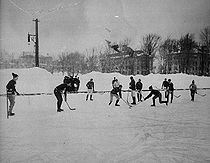
Canada's National symbols are influenced by natural, historical, and First Nations sources. The use of the maple leaf as a Canadian symbol dates to the early 18th century. The maple leaf is depicted on Canada's current and previous flags, on the penny, and on the Coat of Arms.[129] Other prominent symbols include the beaver, Canada Goose, Common Loon, the Crown, the Royal Canadian Mounted Police,[129] and more recently, the totem pole and Inukshuk.
Canada's official national sports are hockey in the winter and lacrosse in the summer.[130] Hockey is a national pastime and the most popular spectator sport in the country. It is also the sport most played by Canadians, with 1.65 million participants in 2004.[131] Canada's six largest metropolitan areas—Toronto, Montreal, Vancouver, Ottawa, Calgary, and Edmonton—have franchises in the National Hockey League (NHL), and there are more Canadian players in the NHL than from all other countries combined. Other popular spectator sports include curling and football; the latter is played professionally in the Canadian Football League (CFL). Golf, baseball, skiing, soccer, volleyball, and basketball are widely played at youth and amateur levels,[131] but professional leagues and franchises are not widespread.
Canada has hosted several high-profile international sporting events, including the 1976 Summer Olympics in Montreal, the 1988 Winter Olympics in Calgary, and the 2007 FIFA U-20 World Cup. Canada was the host nation for the 2010 Winter Olympics in Vancouver and Whistler, British Columbia.[132]
Language
[edit]
Canada's two official languages are English and French. Official bilingualism is defined in the Canadian Charter of Rights and Freedoms, the Official Languages Act, and Official Language Regulations; it is applied by the Commissioner of Official Languages. English and French have equal status in federal courts, Parliament, and in all federal institutions. Citizens have the right, where there is sufficient demand, to receive federal government services in either English or French, and official-language minorities are guaranteed their own schools in all provinces and territories.[133]
English and French are the mother tongues of 59.7% and 23.2% of the population respectively,[134] and the languages most spoken at home by 68.3% and 22.3% of the population respectively.[135] 98.5% of Canadians speak English or French (67.5% speak English only, 13.3% speak French only, and 17.7% speak both).[136] English and French Official Language Communities, defined by First Official Language Spoken, constitute 73.0% and 23.6% of the population respectively.[136]
The Charter of the French Language makes French the official language in Quebec.[137] Although more than 85% of French-speaking Canadians live in Quebec, there are substantial Francophone populations in Ontario, Alberta, and southern Manitoba; Ontario has the largest French-speaking population outside Quebec.[138] New Brunswick, the only officially bilingual province, has a French-speaking Acadian minority constituting 33% of the population. There are also clusters of Acadians in southwestern Nova Scotia, on Cape Breton Island, and through central and western Prince Edward Island.[139]
Other provinces have no official languages as such, but French is used as a language of instruction, in courts, and for other government services in addition to English. Manitoba, Ontario, and Quebec allow for both English and French to be spoken in the provincial legislatures, and laws are enacted in both languages. In Ontario, French has some legal status but is not fully co-official.[140] Several aboriginal languages have official status in the Northwest Territories.[141] Inuktitut is the majority language in Nunavut, and one of three official languages in the territory.[142]
Over six million people in Canada list a non-official language as their mother tongue. Some of the most common non-official first languages include Chinese (mainly Cantonese; 1,012,065 first-language speakers), Italian (455,040), German (450,570), Punjabi (367,505) and Spanish (345,345).[134]
International rankings
[edit]| Organization | Survey | Ranking |
|---|---|---|
| State of World Liberty Project | State of World Liberty Index[143] | 3 out of 159 |
| United Nations Development Programme | Human Development Index[2] | 4 out of 182 |
| World Bank | Ease of Doing Business 2009[144] | 8 out of 181 |
| The Economist | The World in 2005 – Worldwide quality-of-life index, 2005[145] | 14 out of 111 |
| Yale University/Columbia University | Environmental Sustainability Index, 2005[146] | 6 out of 146 |
| Reporters Without Borders | Press Freedom Index 2009[147] | 19 out of 175 |
| Transparency International | Corruption Perceptions Index 2009[148] | 8 out of 180 |
| Institute for Economics & Peace | Global Peace Index[149] | 8 out of 144 |
| Fund for Peace | Failed States Index, 2009[150] | 166 out of 177[151] |
| World Economic Forum | Global Competitiveness Report[152] | 9 out of 133 |
| The Economist | Democracy Index[153] | 11 out of 167 |
See also
[edit]References
[edit]- ^ a b c d "Canada". International Monetary Fund. Retrieved 2009-10-01.
- ^ a b "Human Development Report 2009" (PDF). United Nations Development Program. 2009. p. 171. Retrieved 2010-02-07.
- ^ a b c d "The World Factbook: Canada". Central Intelligence Agency. 2006-05-16. Retrieved 2009-10-19.
- ^ a b "Territorial evolution" (html/PDF). Atlas of Canada. Natural Resources Canada. Retrieved 2007-10-09.
- ^ "Canada: History" (html/PDF). Country Profiles. Commonwealth Secretariat. Retrieved 2007-10-09.
- ^ Cinq-Mars, J (2001). "On the significance of modified mammoth bones from eastern Beringia" (PDF). The World of Elephants – International Congress, Rome. Retrieved 2010-02-25.
- ^ Wright, JV (2001-09-27). "A History of the Native People of Canada: Early and Middle Archaic Complexes". Canadian Museum of Civilization Corporation. Retrieved 2009-10-19.
- ^ a b Wilson, Donna M (2008). Dying and Death in Canada. Toronto: University of Toronto Press. pp. 25–27. ISBN 9781551118734.
{{cite book}}: Unknown parameter|coauthors=ignored (|author=suggested) (help) - ^ Robertson, Ronald G (2001). Rotting face : smallpox and the American Indian. Caldwell, Idaho: Caxton Press. pp. 107–108. ISBN 0870044192.
- ^ Morton, Desmond (2001). A Short History of Canada (6th ed.). Toronto: McClelland & Stewart. pp. 9–17. ISBN 0-7710-6509-4.
- ^ Morton, Desmond (2001) (pp. 17–19)
- ^ Morton, Desmond (2001) (p. 33)
- ^ Smith, Philip (April 1987). "Transhuman Europeans Overseas: The Newfoundland Case". Current Anthropology. 28 (2). University of Chicago Press: 241–250.
- ^ Morton, Desmond (2001) (pp. 89–104)
- ^ Sarkonak, Ralph (1983). "A Brief Chronology of French Canada, 1534–1982". Yale French Studies (65). Yale University Press: 275–282.
- ^ a b c Cite error: The named reference
bucknerwas invoked but never defined (see the help page). - ^ Bumsted, JM (1987). Land, settlement, and politics on eighteenth-century Prince Edward Island. McGill-Queen's University Press. p. 30. ISBN 0773505660.
- ^ Moore, Christopher (1994). The Loyalist: Revolution Exile Settlement. Toronto: McClelland & Stewart. ISBN 0-7710-6093-9.
- ^ McNairn, Jeffrey L (2000). The capacity to judge. Toronto: University of Toronto Press. p. 24. ISBN 0802043607.
- ^ Haines, Michael (2000). A population history of North America. Cambridge University Press. p. 380. ISBN 9780521496667.
{{cite book}}: Unknown parameter|coauthors=ignored (|author=suggested) (help) - ^ "Immigration History of Canada". Marianopolis College. 2004. Retrieved 2008-01-26.
- ^ This is a photograph taken in 1885 of the now-destroyed 1884 painting.
- ^ Romney, Paul (Spring 1989). "From Constitutionalism to Legalism: Trial by Jury, Responsible Government, and the Rule of Law in the Canadian Political Culture". Law and History Review. 7 (1). University of Illinois Press: 128.
- ^ Evenden, Leonard J (1992). "The Pacific Coast Borderland and Frontier". In Donald G. Janelle (ed.). Geographical snapshots of North America. Guilford Press. p. 52. ISBN 0898620309.
{{cite book}}: Unknown parameter|coauthors=ignored (|author=suggested) (help) - ^ Bothwell, Robert (1996). History of Canada Since 1867. East Lansing, MI: Michigan State University Press. pp. 207–310. ISBN 0-87013-399-3.
- ^ Bumsted, JM (1996). The Red River Rebellion. Winnipeg: Watson & Dwyer. ISBN 0920486231.
- ^ a b "Building a nation". The Canadian Atlas. Retrieved 2009-09-18.
- ^ Bothwell, Robert (1996) (p. 31).
- ^ "Sir John A. Macdonald". Library and Archives Canada. 2008. Retrieved 2009-09-18.
- ^ Cook, Terry (2000). "The Canadian West: An Archival Odyssey through the Records of the Department of the Interior". The Archivist. Library and Archives Canada. Retrieved 2009-09-18.
- ^ a b c d e f g h Morton, Desmond (1999). A military history of Canada (4th ed.). Toronto: McClelland & Stewart. pp. 130–158, 173, 203–233. ISBN 0771065140.
- ^ Haglund, David G (1999). Security, strategy and the global economics of defence production. McGill-Queen's University Press. p. 12. ISBN 0889118752.
{{cite book}}: Unknown parameter|coauthors=ignored (|author=suggested) (help) - ^ Dellinger, Walter (Autumn 1982). "The Amending Process in Canada and the United States: A Comparative Perspective". Law & Contemporary Problems. 45 (4). Duke Law School: 291.
- ^ Young, Walter (1983). "Canada: The Social Democracy of Provincial Government in a Federal System". In Peter Davis (ed.). Social Democracy in the South Pacific. Vol. 2. Auckland, New Zealand: Ross. pp. 48–58. ISBN 0908636350.
- ^ a b Goddard, Lance (2005). Canada and the Liberation of the Netherlands. Dundurn Press Ltd. pp. 225–232. ISBN 1550025473.
- ^ Stacey, CP (1948). History of the Canadian Army in the Second World War. Queen's Printer.
- ^ Mackey, Eva (2002). The house of difference: cultural politics and national identity in Canada. Toronto: University of Toronto Press. p. 57. ISBN 0802084818.
- ^ Esman, Milton J (Summer 1982). "The Politics of Official Bilingualism in Canada". Political Science Quarterly. 97 (2). The Academy of Political Science: 233–253.
- ^ Esses, Victoria M (July 1996). "Multiculturalism in Canada: Context and current status". Canadian Journal of Behavioural Science. 28 (3). American Psychological Association: 145–152.
{{cite journal}}: Unknown parameter|coauthors=ignored (|author=suggested) (help) - ^ Sarrouh, Elissar (2002-01-22). "Social Policies in Canada: A Model for Development" (PDF). Social Policy Series, No. 1. United Nations. pp. 14–16, 22–37. Retrieved 2010-01-17.
- ^ a b James Bickerton, Alain Gagnon, ed. (2004). Canadian Politics (4th ed.). Orchard Park, NY: Broadview Press. ISBN 1-55111-595-6.
- ^ a b Clift, Dominique (1982). Quebec nationalism in crisis (reissued ed.). McGill-Queen's University Press. pp. 28–36, 96–99, 106–107. ISBN 0773503838.
- ^ a b Dickinson, John Alexander (2003). A Short History of Quebec (3rd ed.). Montreal: McGill-Queen's University Press. ISBN 0-7735-2450-9.
{{cite book}}: Unknown parameter|coauthors=ignored (|author=suggested) (help) - ^ Dawson, R MacGregor (1989). Norman Ward (ed.). Democratic Government in Canada. Toronto: University of Toronto Press. pp. 16–17, 59–60, 66. ISBN 0802067034.
{{cite book}}: Unknown parameter|coauthors=ignored (|author=suggested) (help) - ^ Hicks, Bruce M (2008). "Restructuring the Canadian Senate through Elections". IIRP Choices. 14 (14). Institute for Research on Public Policy: 11.
{{cite journal}}: Unknown parameter|coauthors=ignored (|author=suggested) (help) - ^ Stevenson, Garth (2004). Unfulfilled union: Canadian federalism and national unity (4th ed.). McGill-Queen's University Press. p. 30. ISBN 0773527443.
- ^ "Difference between Canadian Provinces and Territories". Intergovernment Affairs Canada. 2009. Retrieved 2009-09-19.
- ^ "A Comparison of Provincial & Territorial Governments". Legislative Assembly of the Northwest Territories. 2008. Retrieved 2010-03-10.
- ^ "Frequently Asked Questions". Legislative Assembly of Nunavut. 2008. Retrieved 2009-09-19.
- ^ Commonwealth public administration reform 2004. Commonwealth Secretariat. 2004. pp. 54–55. ISBN 0117032492.
- ^ Johnson, David (2006). Thinking government: public sector management in Canada (2nd ed.). Toronto: University of Toronto Press. pp. 134–135, 149. ISBN 1551117797.
- ^ Forsey, Eugene A (2005). How Canadians Govern Themselves (PDF) (6th ed.). Ottawa: Canada. p. 16. ISBN 0-662-39689-8. Retrieved 2009-10-20.
- ^ Jean, Michaëlle (November 2005). "Canada : terre de liberté et d'aventures". Policy Options (in French). 26 (9). Institute for Research on Public Policy: 5–6.
- ^ "Prime Minister of Canada". Office of the Prime Minister. 2009. Retrieved 2009-10-23.
- ^ "Michael Ignatieff". Liberal Party of Canada. Federal Liberal Agency of Canada. 2009. Retrieved 2009-10-23.
- ^ a b Bakan, Joel (2003). Canadian Constitutional Law. Emond Montgomery Publications. pp. 3–8, 683–687, 699. ISBN 1552390853.
{{cite book}}: Unknown parameter|coauthors=ignored (|author=suggested) (help) - ^ McCormick, Peter (2000). Supreme at last: the evolution of the Supreme Court of Canada. James Lorimer & Company Ltd. pp. 2, 86, 154. ISBN 1550286927.
- ^ "About the Court". Supreme Court of Canada. 2009. Retrieved 2009-09-20.
- ^ a b Sworden, Philip James (2006). An introduction to Canadian law. Emond Montgomery Publications. pp. 22, 150. ISBN 1552391450.
- ^ "Keeping Canada and Our Communities Safe and Secure". RCMP. Retrieved 2009-09-20.
- ^ Haglung, David G (Autumn 2003). "North American Cooperation in an Era of Homeland Security". Orbis. 47 (4). Foreign Policy Research Institute: 675–691.
- ^ James, Patrick (2006). Nelson Michaud, Marc J. O'Reilly (ed.). Handbook of Canadian Foreign Policy. Lexington Books. pp. 213–214, 349–362. ISBN 073911493X.
- ^ "About the Canadian Forces". Department of National Defence. Retrieved 2009-12-04.
- ^ "Canadian Forces Equipment". Department of National Defence. Retrieved 2010-02-25.
- ^ Eayrs, James (1980). In Defence of Canada. Toronto: University of Toronto Press. p. 332. ISBN 0-8020-2345-2.
- ^ Canada's international policy statement: a role of pride and influence in the world. Ottawa: Government of Canada. 2005. ISBN 0-662-68608-X. Retrieved 2010-01-19.
- ^ Finkel, Alvin (1997). Our lives: Canada after 1945. Lorimer. pp. 105–107, 111–116. ISBN 1550285513.
- ^ Holloway, Steven Kendall (2006). Canadian foreign policy: defining the national interest. Toronto: University of Toronto Press. pp. 102–103. ISBN 1551118165.
- ^ Morton, Desmond (1999) (p. 258)
- ^ "UN Peacekeeping Current Operations". United Nations Association Canada. Retrieved 2009-10-15.
- ^ "The UN and peacekeeping". United Nations Association Canada. Retrieved 2009-10-15.
- ^ "Canada and the Organization of American States (OAS)". Canadian Heritage. 2008. Retrieved 2009-09-20.
- ^ "Opening Doors to Asia". Foreign Affairs and International Trade Canada. 2009. Retrieved 2009-09-20.
- ^ Freeze, Colin (2009-05-29). "A question of protection in Afghanistan". Globe and Mail. Retrieved 2009-06-20. Registration required
- ^ "Cost of the Afghanistan mission 2001–2011". Canada's Engagement in Afghanistan. Government of Canada. 2009-02-25. Retrieved 2009-05-13.
- ^ Konrad, Victor (2008). Beyond walls: re-inventing the Canada-United States borderlands. Ashgate Publishing. pp. 189, 196. ISBN 0754672026.
{{cite book}}: Unknown parameter|coauthors=ignored (|author=suggested) (help) - ^ Vagnoni, Giselda (2007-02-06). "Rich nations to sign $1.5 bln vaccine pact in Italy". Reuters. Retrieved 2010-01-18.
- ^ Blomfield, Adrian (2007-08-03). "Russia claims North Pole with Arctic flag stunt". Telegraph. Retrieved 2009-10-19.
- ^ Bird, Richard M (2008-10-22). "Government Finance". Historical Statistics of Canada. Statistics Canada. Retrieved 2010-03-17.
- ^ "The World Factbook". Central Intelligence Agency. 2006-05-16. Retrieved 2010-03-09.
- ^ "Territorial Evolution, 1927". National Resources Canada. 2004-04-06. Retrieved 2006-05-14.
- ^ Susic, Stela (2006-08-15). "Air Force becomes command authority for CFS Alert". The Maple Leaf. 12 (17). National Defence Canada. Retrieved 2006-10-03.
- ^ "Population Density, 2001". The Atlas of Canada. Natural Resources Canada. 2005-06-15. Retrieved 2010-01-18.
- ^ "Significant Canadian Facts". Natural Resources Canada. 2004-04-05. Retrieved 2006-05-16.
- ^ National Atlas of Canada. Ottawa: Natural Resources Canada. 2005. p. 1. ISBN 0-7705-1198-8.
- ^ Pearce, EA; Smith, CG (1984). The Times Books world weather guide: a city-by-city guide. New York Times Books. p. 116. ISBN 0812911237.
{{cite book}}: CS1 maint: multiple names: authors list (link) - ^ Bailey, William G (1997). The surface climates of Canada. McGill-Queen's University Press. p. 124. ISBN 0773516727.
{{cite book}}: Unknown parameter|coauthors=ignored (|author=suggested) (help) - ^ The Weather Network. "Statistics, Regina SK". Internet Archive. Retrieved 2010-01-18.
- ^ "Canadian Climate Normals or Averages 1971–2000". Environment Canada. 2004-02-25. Retrieved 2010-01-18.
- ^ Etkin, David (2003-04-30). An Assessment of Natural Hazards and Disasters in Canada. Springer. pp. 569, 582, 583. ISBN 978-1402011795.
{{cite book}}: Unknown parameter|coauthors=ignored (|author=suggested) (help) - ^ "Tseax Cone". Catalogue of Canadian volcanoes. Geological Survey of Canada. 2005-08-19. Retrieved 2008-07-29.
- ^ "Latest release". World Trade Organization. 2008-04-17. Retrieved 2008-07-03.
- ^ "Index of Economic Freedom". The Heritage Foundation and the Wall Street Journal. 2009. Retrieved 2009-01-09.
- ^ a b "Imports, exports and trade balance of goods on a balance-of-payments basis, by country or country grouping". Statistics Canada. 2009-11-16. Retrieved 2010-01-17.
- ^ "Latest release from Labour Force Survey". Statistics Canada. 2009-11-06. Retrieved 2009-11-18.
- ^ "Budget 2008: Budget Plan—Annex 1". Department of Finance. Retrieved 2010-02-26.
- ^ "Government of Canada Debt Management Report". Department of Finance. 2009-12-16. Retrieved 2010-02-08.
- ^ "Employment by Industry". Statistics Canada. 2009-01-08. Retrieved 2009-10-19.
- ^ a b Brown, Charles E (2002). World energy resources. Springer. pp. 323, 378–389. ISBN 3540426345.
- ^ Clarke, Tony; Campbell, Bruce; Laxer, Gordon (2006-03-10). "US oil addiction could make us sick". Parkland Institute. Retrieved 2006-05-18.
{{cite web}}: CS1 maint: multiple names: authors list (link) - ^ a b Britton, John NH (1996). Canada and the Global Economy: The Geography of Structural and Technological Change. McGill-Queen's University Press. pp. 26–27, 155–163. ISBN 0773513566.
- ^ Leacy, FH (ed.) (1983). "Vl-12". Statistics Canada. Retrieved 2010-01-18.
{{cite web}}:|first=has generic name (help) - ^ Granatstein, JL (1997). Yankee Go Home: Canadians and Anti-Americanism. Toronto: HarperCollins. ISBN 0-00-638541-9.
- ^ Morck, Randall (2005). "Who owns whom? Economic nationalism and family controlled pyramidal groups in Canada". In Lorraine Eden, Wendy Dobson (ed.). Governance, multinationals, and growth. Edward Elgar Publishing. p. 50. ISBN 1843769093.
{{cite book}}: Unknown parameter|coauthors=ignored (|author=suggested) (help) - ^ Jenkins, Barbara L (1992). The paradox of continental production. Cornell University Press. p. 117. ISBN 0801426766.
- ^ "Jean Chrétien". CBC. 2009-07-13. Retrieved 2009-10-20.
- ^ Sturgeon, Jamie (2009-03-13). "Jobless rate to peak at 10%: TD". National Post. Retrieved 2009-10-20.
- ^ "Census metropolitan area (CMA) and census agglomeration (CA)". Illustrated Glossary. November 15, 2017. Retrieved September 8, 2023.
- ^ Beauchesne, Eric (2007-03-13). "We are 31,612,897". National Post. Retrieved 2007-03-13.
- ^ Custred, Glynn (2008). "Security Threats on America's Borders". In Alexander Moens (ed.). Immigration policy and the terrorist threat in Canada and the United States. Fraser Institute. p. 96. ISBN 0889752354.
- ^ "Urban-rural population as a proportion of total population, Canada, provinces, territories and health regions". Statistics Canada. 2001. Retrieved 2009-04-23.
- ^ "Population by selected ethnic origins, by province and territory (2006 Census) (Canada)". Statistics Canada. 2009-07-28. Retrieved 2010-01-19.
- ^ "One in 6 Canadians is a visible minority". CBC. 2008-04-02. Retrieved 2009-10-20.
- ^ a b "2006 Census: Ethnic origin, visible minorities, place of work and mode of transportation". The Daily. Statistics Canada. 2008-04-02. Retrieved 2010-01-19.
- ^ Cardozo, Andrew (August 2008). "Canada's Visible Minority Population: 1967–2017" (PDF). Centre of Excellence for Research on Immigration and Diversity. Retrieved 2010-01-19.
{{cite web}}: Unknown parameter|coauthors=ignored (|author=suggested) (help) - ^ "Vancouver". Statistics Canada. 2009-07-24. Retrieved 2009-10-20.
- ^ "Toronto". Statistics Canada. 2009-07-24. Retrieved 2009-10-20.
- ^ a b "The Daily, Tuesday, December 4, 2007. 2006 Census: Immigration, citizenship, language, mobility and migration". Statistics Canada. 2007-12-04. Retrieved 2009-10-19.
- ^ a b c d "Population by religion, by province and territory (2001 Census)". Statistics Canada. 2005-01-25. Retrieved 2010-01-19.
- ^ "Government of Canada Tables 2010 Immigration Plan". Canada News Centre. Retrieved 2010-01-24.
- ^ "When immigration goes awry". Toronto Star. 2006-07-14. Retrieved 2010-01-08.
- ^ Martel, Laurent (2009-09-22). "2006 Census: Portrait of the Canadian Population in 2006, by Age and Sex". Statistics Canada. Retrieved 2009-10-18.
{{cite web}}: Unknown parameter|coauthors=ignored (|author=suggested) (help) - ^ a b "Overview of Education in Canada". Council of Ministers of Education, Canada. Retrieved 2009-10-20.
- ^ "Creating Opportunities for All Canadians". Department of Finance Canada. 2005-11-14. Retrieved 2006-05-22.
- ^ Will Kaufman, Heidi Slettedahl MacPherson, ed. (2005). "Settlement Policies". Britain and the Americas: culture, politics, and history. ABC-CLIO. p. 888. ISBN 1851094318.
- ^ Dollinger, Stefan (2008). New-dialect formation in Canada: evidence from the English modal auxiliaries. John Benjamins. p. 66. ISBN 9027231087.
- ^ Blackwell, John D (2005). "Culture High and Low". International Council for Canadian Studies World Wide Web Service. Retrieved 2006-03-15.
- ^ "Mandate of the National Film Board" (pdf). National Film Board of Canada. 2005. Retrieved 2009-10-20.
- ^ a b Canadian Heritage (2002). Symbols of Canada. Ottawa, ON: Canadian Government Publishing. ISBN 0-660-18615-2.
- ^ Wieting, Stephen G (2001). Sport and memory in North America. Frank Cass. p. 4. ISBN 0714682055.
- ^ a b Conference Board of Canada (2004). "Survey: Most Popular Sports, by Type of Participation, Adult Population". Strengthening Canada: The Socio-economic Benefits of Sport Participation in Canada—Report August 2005. Sport Canada. Retrieved 2006-07-01.
{{cite web}}: Unknown parameter|month=ignored (help) - ^ "Vancouver 2010". The Vancouver Organizing Committee for the 2010 Olympic and Paralympic Winter Games. 2009. Retrieved 2009-10-20.
- ^ "Federal Legislation on Official Languages". Office of the Commissioner of Official Languages. 2007. Retrieved 2009-10-20.
- ^ a b "Population by mother tongue, by province and territory". Statistics Canada. 2005-01-27. Retrieved 2010-01-19.
- ^ "First Official Language Spoken (7) and Sex (3) for Population, for Canada, Provinces, Territories and Census Metropolitan Areas 1, 2001 Census – 20% Sample Data". Statistics Canada, 2001 Census of Population. Retrieved 2007-03-23.
- ^ a b "Population by knowledge of official language, by province and territory". Statistics Canada. 2005-01-27. Retrieved 2009-10-20.
- ^ Daoust, Denise (1990). "A Decade of Language Planning in Quebec: A Sociopolitical Overview". In Brian Weinstein (ed.). Language Policy and Political Development. Ablex Publishing Corporation. p. 108. ISBN 0893916110.
- ^ Lachapelle, R (March 2009). "The Diversity of the Canadian Francophonie". Statistics Canada. Retrieved 2009-09-24.
- ^ Hayday, Matthew (2005). Bilingual Today, United Tomorrow: Official Languages in Education and Canadian Federalism. McGill-Queen's University Press. p. 49. ISBN 0773529608.
- ^ Arnopoulos, Sheila McLeod (1982). Voices from French Ontario. McGill-Queen's University Press. pp. 77–81. ISBN 0773504060.
- ^ Fettes, Mark (2001). "Voices of Winter: Aboriginal Languages and Public Policy in Canada". In Marlene Brant Castellano, Lynne Davis, Louise Lahache (ed.). Aboriginal education: fulfilling the promise. UBC Press. p. 39. ISBN 0774807830.
{{cite book}}: Unknown parameter|coauthors=ignored (|author=suggested) (help)CS1 maint: multiple names: editors list (link) - ^ Russell, Peter H (2005). "Indigineous Self-Determination: Is Canada as Good as it Gets?". In Barbara Hocking (ed.). Unfinished constitutional business?: rethinking indigenous self-determination. Aboriginal Studies Press. p. 180. ISBN 0855754664.
- ^ "The 2006 State of World Liberty Index". State of World Liberty Project. Retrieved 2007-12-07.
- ^ "Doing Business in Canada". World Bank Group. 2010. Retrieved 2010-02-07.
- ^ "The world's best country". The Economist. 2004-11-17. Retrieved 2010-02-07.
- ^ "2005 Environmental Sustainability Index" (PDF). Yale Center for Environmental Law and Policy, Yale University; Center for International Earth Science Information Network, Columbia University. 2005. p. 4. Retrieved 2010-02-07.
- ^ "Press Freedom Index 2009". Reporters Without Borders. Retrieved 2010-02-07.
- ^ "Corruption Perceptions Index 2009". Transparency International. Retrieved 2010-02-07.
- ^ "2009 Methodology, Results & Findings" (PDF). Institute for Economics & Peace. 2009. p. 10. Retrieved 2010-02-07.
- ^ "Failed States Index Scores 2009". Fund for Peace. 2010. Retrieved 2010-02-07.
- ^ Larger number indicates sustainability
- ^ "The Global Competitiveness Report 2009-2010". World Economic Forum. 2009. Retrieved 2010-02-07.
- ^ "The Economist Intelligence Unit's Index of Democracy 2008" (PDF). The Economist. 2008. p. 4. Retrieved 2010-02-07.
{{cite web}}: Italic or bold markup not allowed in:|publisher=(help)
Further reading
[edit]
|
|
External links
[edit]- Government
- Official website of the Government of Canada
- Official website of the Governor General of Canada
- Official website of the Prime Minister of Canada
- Crown corporations
- Other
- Canada at UCB Libraries GovPubs
- Canadian Studies: A Guide to the Sources
Template:Featured article is only for Wikipedia:Featured articles.
References
[edit]External links
[edit]


